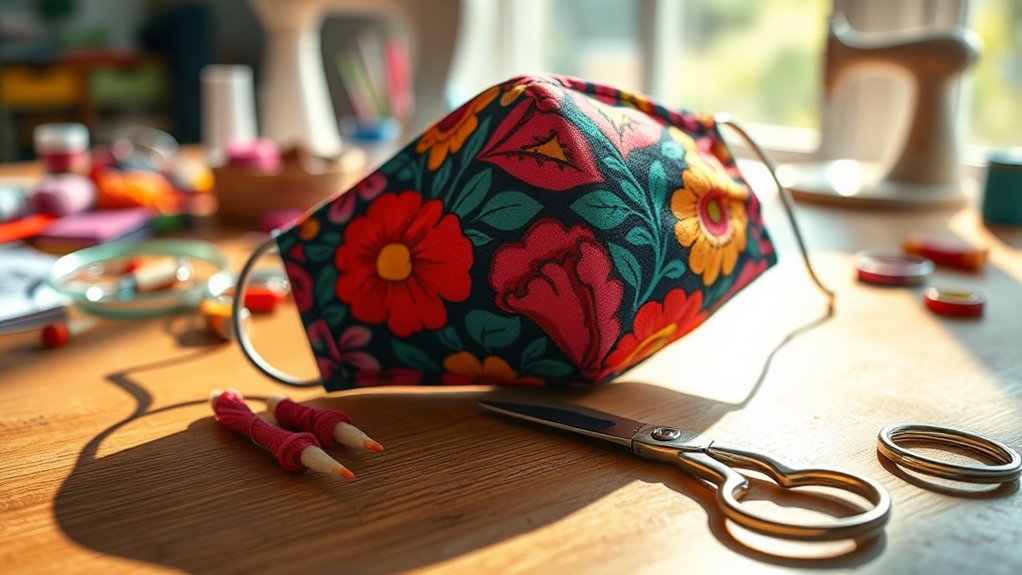DIY Face Mask That Went Viral for a Reason
You’ve probably heard about the DIY face mask that’s taken the skincare world by storm. Combining natural ingredients like honey, yogurt, and turmeric, it promises hydration and a radiant glow. But what makes this mask so effective? As you discover its benefits and learn how to customize it for your skin type, you might just find the perfect addition to your beauty routine. Let’s explore what sets this mask apart.
Key Takeaways
- DIY face masks gained popularity for their customizable ingredients tailored to specific skin types and concerns.
- Natural components like honey and avocado are gentler on the skin, reducing irritation compared to commercial options.
- Viral recipes often feature effective, readily available ingredients such as charcoal for detoxifying and turmeric for brightening.
- The fun and creative aspect of making your own mask enhances user engagement and sharing on social media platforms.
- Immediate skin benefits, like hydration and a natural glow, contribute to their viral appeal and user satisfaction.
The Ingredients That Make It Viral
When you think about creating a DIY face mask that garners attention, the right ingredients can make all the difference. Start with a base that suits your skin type—honey for hydration, yogurt for exfoliation, or clay for oil control.
Then, consider powerful additions like activated charcoal to detoxify or turmeric to brighten and reduce inflammation. Antioxidant-rich ingredients, such as green tea or vitamin E, can elevate your mask’s effectiveness. Incorporating lemon juice can further enhance your mask by helping to naturally brighten skin tone and reduce hyperpigmentation.
Don’t forget the scent; essential oils like lavender or tea tree not only enhance the experience but also offer their own skin benefits. By combining these ingredients thoughtfully, you’ll craft a DIY face mask that not only works wonders but also captures the interest of anyone who tries it.
Step-by-Step Preparation Method
Creating a DIY face mask is easy and can be done in just five simple steps. Follow this method to craft your own rejuvenating mask:
-
Gather Ingredients: Collect your chosen ingredients based on your skin type, such as avocado, honey, or yogurt.
-
Mix: In a bowl, combine the ingredients thoroughly until you achieve a smooth consistency.
-
Prep Your Skin: Cleanse your face to remove any dirt or makeup, allowing the mask to penetrate effectively.
-
Apply: Using your fingertips or a brush, evenly spread the mask over your face, avoiding the eye area. Honey is known for its natural healing properties, making it an excellent base for your mask.
Now you’re ready to let the mask sit for the recommended time before rinsing it off with warm water.
Enjoy your fresh, glowing skin!
Benefits for Different Skin Types
Understanding the benefits of a DIY face mask for different skin types can transform your skincare routine.
If you have oily skin, a mask with clay can absorb excess oil and unclog pores, giving you a fresh, matte finish.
For dry skin, incorporating ingredients like honey or avocado provides deep hydration, enhancing your skin’s natural glow.
If you struggle with sensitivity, soothing ingredients such as oatmeal or aloe vera can calm irritation and redness.
Meanwhile, those with combination skin can benefit from balancing elements that target both oily and dry areas.
Tailoring your mask to your skin type not only optimizes its effectiveness but also fosters a personalized approach that respects your unique skin needs. Additionally, using all-natural ingredients can further enhance the health benefits of your DIY face mask.
Embrace this mastery for radiant skin!
How to Customize the Mask for Your Needs
To truly make a DIY face mask work for you, start by identifying your specific skin concerns and choosing ingredients that address them directly.
Here’s how to customize your mask effectively:
-
Hydration: Add honey or aloe vera for moisture if your skin feels dry.
-
Exfoliation: Incorporate sugar or coffee grounds to slough off dead skin cells.
-
Brightening: Use lemon juice or turmeric to enhance your skin’s radiance and tackle dullness.
-
Acne Control: Mix in tea tree oil or clay to help reduce breakouts and absorb excess oil.
Additionally, honey’s natural properties provide antibacterial benefits that can further enhance your mask’s effectiveness.
Experiment with these ingredients, adjusting ratios as needed, to achieve the perfect blend for your skin.
You’ll master the art of DIY face masks in no time!
Real User Testimonials
You’ve likely heard amazing stories from others who’ve transformed their skin with DIY face masks.
Many users share how these masks fit seamlessly into their daily routines while delivering impressive results.
Let’s explore some of these real experiences and see how they can inspire your own skincare journey. Additionally, many users attribute their success to the natural ingredients that are scientifically proven to enhance skin vitality and reduce signs of aging.
Skin Transformation Stories
Many users have experienced remarkable skin transformations after incorporating DIY face masks into their skincare routines.
Here are some inspiring testimonials that showcase the power of these homemade treatments:
-
Acne Reduction: Users report significant decreases in breakouts and blemishes, leading to smoother skin.
-
Hydration Boost: Many have found that natural ingredients deeply hydrate, leaving their skin plump and radiant.
-
Even Skin Tone: Several individuals noticed a reduction in hyperpigmentation and dark spots, achieving a more uniform complexion.
-
Glow Enhancement: Users rave about the instant glow that follows a DIY mask, making their skin look revitalized and fresh.
These stories highlight the potential of DIY face masks, empowering you to transform your skin effectively and affordably.
Everyday Use Experiences
How often do you reach for a DIY face mask to enhance your skincare routine? If you’re like many, you find that these masks become a staple in your regimen.
Users rave about the immediate glow and hydration they experience after applying simple ingredients like honey and avocado. One user shared that using a weekly mask transformed her dull complexion, leaving her skin radiant and rejuvenated.
Another mentioned how easily customizable these masks are, allowing her to target specific concerns like dryness or acne.
You’ll discover that incorporating a DIY face mask not only elevates your skincare but becomes a moment of self-care you look forward to. With each application, you gain mastery over your skin’s health and appearance.
Tips for Optimal Application
To achieve the best results when applying your DIY face mask, preparation is key. Follow these tips for ideal application:
-
Cleanse Your Skin: Start with a gentle cleanser to remove dirt and oils, ensuring your mask can penetrate effectively.
-
Exfoliate: Use a mild exfoliant to slough off dead skin cells. This enhances absorption and promotes a smoother application.
-
Warm Up: Slightly warm your mask in your hands or with a warm towel. This can help it spread evenly and feel more soothing.
-
Apply Evenly: Use clean fingers or a brush to apply the mask in a thin, even layer, focusing on areas that need the most attention.
Common Mistakes to Avoid
While applying a DIY face mask can be a rejuvenating experience, there are common mistakes you should steer clear of to enhance its benefits.
First, don’t skip the patch test; this helps avoid allergic reactions.
When applying, make sure your face is clean and dry—this allows for better absorption.
Avoid using too much product; a thin, even layer is often more effective.
Don’t leave the mask on for longer than recommended; overdoing it can irritate your skin.
Remember, it’s crucial to rinse with lukewarm water, not hot, as extreme temperatures can be harsh.
Finally, don’t forget to moisturize afterward; this helps lock in hydration and keeps your skin feeling soft and supple.
Master these tips for ideal results!
How Often to Use the Mask
Knowing how often to use your DIY face mask depends on your skin type and its specific needs.
For oily skin, you might benefit from using it more frequently, while dry or sensitive skin may require a gentler approach.
Let’s explore the best frequency recommendations to keep your skin healthy and glowing.
Skin Type Considerations
Understanding your skin type is essential for determining how often you should use a DIY face mask. Different skin types react uniquely, and knowing yours helps you tailor your routine effectively. Here’s a quick guide:
-
Oily Skin: Use the mask 2-3 times a week to control excess oil and prevent breakouts.
-
Dry Skin: Limit to once a week; overdoing it can strip natural moisture.
-
Combination Skin: Use 1-2 times a week, focusing on areas that need attention.
-
Sensitive Skin: Stick to once every two weeks; this minimizes irritation and allows your skin to recover.
Frequency Recommendations
After identifying your skin type, the next step is determining how often you should use your DIY face mask.
If you have dry or sensitive skin, aim for once a week to prevent irritation and maintain hydration.
For oily or acne-prone skin, using the mask two to three times a week can help manage excess oil and unclog pores.
Combination skin types can benefit from a balanced approach, using the mask once every five to seven days.
Listen to your skin—if it feels overly dry or irritated, reduce frequency.
Always remember to patch test new ingredients and adjust usage based on your skin’s response.
Mastering the frequency will amplify your results and keep your skin glowing.
Storing and Preserving Your DIY Mask
To guarantee your DIY face mask remains effective and safe to use, proper storage is essential. Follow these guidelines to preserve its quality:
-
Cool, Dry Place: Store your mask in a cool, dry area to prevent moisture buildup, which can lead to mold.
-
Breathable Container: Use a breathable container, like a cotton bag or a paper envelope, to allow airflow while keeping dust out.
-
Avoid Direct Sunlight: Keep your mask away from direct sunlight, as UV rays can degrade certain materials over time.
-
Regular Inspection: Check your mask regularly for signs of wear or contamination, and replace it if necessary.
Frequently Asked Questions
Can I Use This Mask on Sensitive Skin?
You can try using this mask on sensitive skin, but patch-test first. If you notice any irritation, it’s best to avoid it or modify the ingredients to suit your skin’s needs better. Always prioritize safety!
How Long Does the Mask Take to Dry?
The mask typically takes about 15 to 30 minutes to dry, depending on your skin type and the application thickness. You’ll know it’s ready when it feels tight and slightly flaky.
Can I Use Essential Oils in the Mask?
Yes, you can use essential oils in the mask! Just remember to choose skin-friendly oils and mix them well. They can enhance the mask’s benefits, but always do a patch test first to avoid irritation.
Is This Mask Suitable for Acne-Prone Skin?
This mask can be suitable for acne-prone skin, but it depends on its ingredients. You should check for non-comedogenic components and avoid irritants. Always patch test before applying it to your entire face.
What Should I Do if I Experience Irritation?
If you experience irritation, stop using the product immediately. Rinse your skin with cool water, apply a soothing moisturizer, and consider an over-the-counter hydrocortisone cream. If irritation persists, consult a dermatologist for tailored advice.

